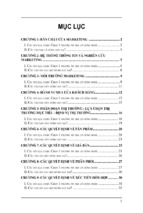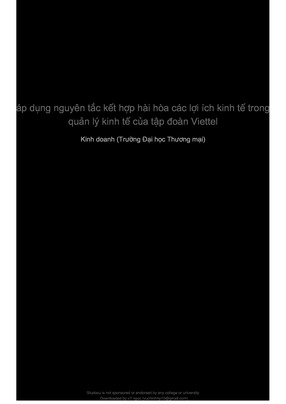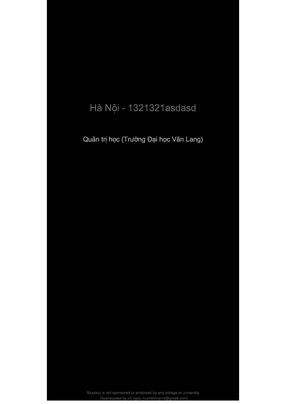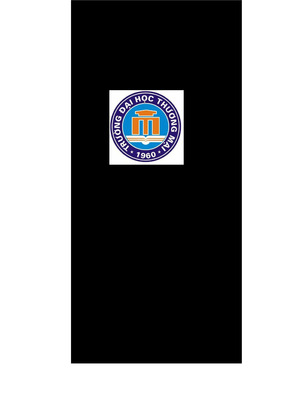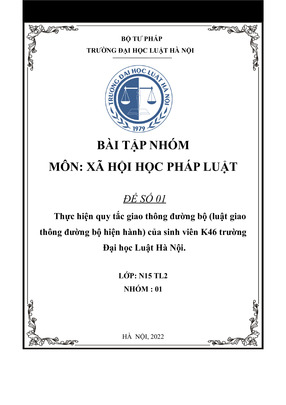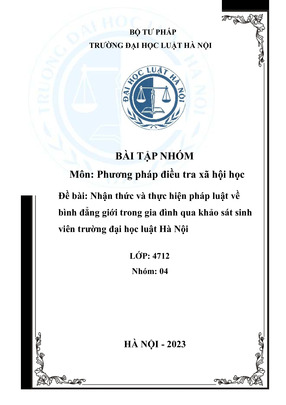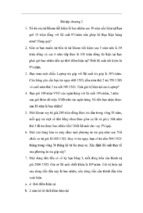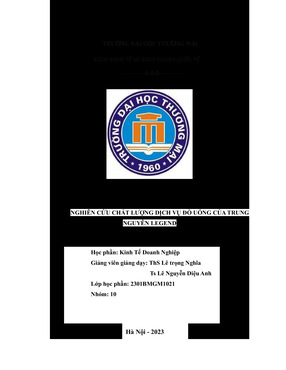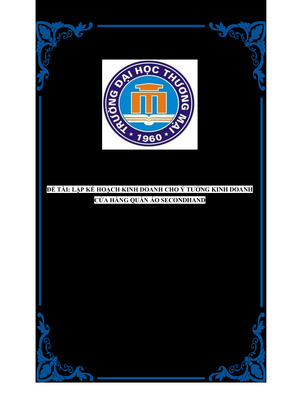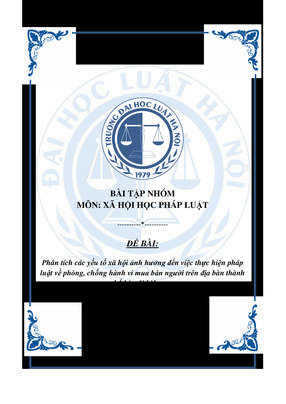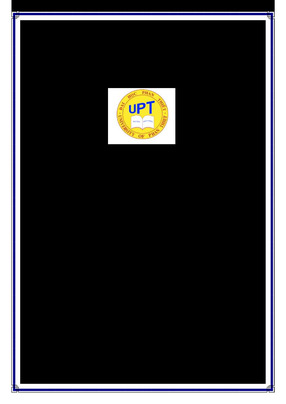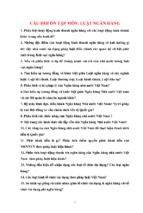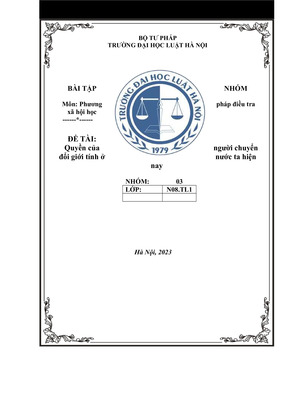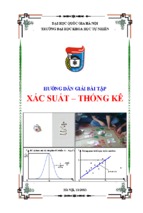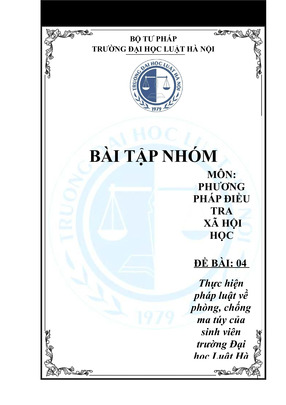PEOPLE‘S COMMITTEE OF BINH DUONG PROVINCE
THU DAU MOT UNIVERSITY
NGUYEN THANH THAI
THE USE OF CONCEPTUAL METAPHORS IN CHILDREN’S
HEALING STORIES
MASTER THESIS
MAJOR: THE ENGLISH LANGUAGE
CODE: 8 22 02 01
BINH DUONG - 2019
PEOPLE‘S COMMITTEE OF BINH DUONG PROVINCE
THU DAU MOT UNIVERSITY
NGUYEN THANH THAI
THE USE OF CONCEPTUAL METAPHORS IN CHILDREN’S
HEALING STORIES
MASTER THESIS
MAJOR: THE ENGLISH LANGUAGE
CODE: 8 22 02 01
SUPERVISOR:
NGUYEN HOANG TUAN, Ph.D.
BINH DUONG - 2019
UBND TỈNH BÌNH DƢƠNG
CỘNG HÒA XÃ HỘI CHỦ NGHĨA VIỆT NAM
TRƯỜNG ĐẠI HỌC THỦ DẦU MỘT
Độc lập – Tự do – Hạnh phúc
Bình Dương, ngày …… tháng …… năm 2019
NHẬN XÉT CỦA NGƯỜI HƯỚNG DẪN KHOA HỌC
1. Họ và tên học viên: Nguyễn Thành Thái
Khoá: 2015-2017
2. Chuyên ngành: NGÔN NGỮ ANH
Mã ngành: 8 22 02 01
3. Đề tài nghiên cứu: The Use of Conceptual Metaphors in Children’s Healing
Stories
4. Họ và tên Ngƣời hƣớng dẫn khoa học: TS. Nguyễn Hoàng Tuấn
5. Nhận xét: (Kết cấu luận văn, xác định đề tài nghiên cứu, mục tiêu nghiên cứu, tổng
quan lý thuyết, phương pháp nghiên cứu, kết quả nghiên cứu, thái độ làm việc của học
viên,…)
Bố cục luận văn hợp lý. Đề tài nghiên cứu phù hợp với mã ngành đào tạo. Mục tiêu
nghiên cứu đƣợc xác định cụ thể: 1) khảo sát và thống kê, phân loại các ẩn dụ ý niệm
trong các văn bản tiếng Anh; 2) xác định các biểu thức tiếng Anh đƣợc dùng để diễn
đạt ý niệm. Cơ sở lí thuyết tƣơng đối đầy đủ, và liên quan đến đề tài. Phƣơng pháp
nghiên cứu phù hợp. Kết quả nghiên cứu có giá trị thực tiễn, giúp hiểu rõ nội dung văn
bản tiếng Anh và có nhiều ứng dụng trong phân tích văn bản, giảng dạy tiếng Anh,
cũng nhƣ trong giao tiếp, giáo dục, điều chỉnh hành vi trẻ em thông qua ẩn dụ tiếng
Anh. Học viên có khả năng nghiên cứu khoa học, khiêm tốn học hỏi và thực hiện
nghiêm túc các công việc đƣợc giao.
6. Kết luận: Đồng ý cho học viên bảo vệ luận văn.
Chữ ký của Ngƣời hƣớng dẫn
(ghi rõ họ tên)
STATEMENT OF AUTHORSHIP
Apart from the references, this thesis does not contain any material
published elsewhere or extracted in whole or in part from a thesis by which I
have qualified for or been awarded another degree or diploma.
This thesis has not also been submitted for the award of any degree or
diploma in any other tertiary institution.
Thus, I hereby certify my authority of the thesis submitted entitled ―The
use of conceptual metaphors in children‘s healing stories‖ in partial fulfillment of
the requirements for the degree of Master of Arts.
Binh Duong, February 2019
Nguyen Thanh Thai
i
ACKNOWLEDGEMENTS
To fulfill this thesis, I own great debt to my supervisor, my lecturers, and
my family.
I would like to express my sincere gratitude and appreciation to my
supervisor, Dr. Nguyen Hoang Tuan, whose wisdom and interesting lectures has
inspired me to conduct this thesis. His encouragement, guidance, patience, and
support of material from the very initial stage to the final stage in accomplishing
this thesis have been invaluable.
I am greatly indebted to all my lecturers at Thu Dau Mot University for
their endless enthusiasm and undeniable helpful lectures. I would be very
grateful to the staff of the Post-graduate Department for their support during the
time of studying.
Last but not least, my warmest thanks are due to my family for their
motivation and encouragement.
To all of them, I dedicate this study.
Binh Duong, February 2019
Nguyen Thanh Thai
ii
ABSTRACT
This thesis is an attempt to analyze the conceptual metaphors used in
children‘s English healing stories on the basis of the application of the
conceptual metaphor theory proposed by Lakoff and Johnson (1980) in the hope
that it provides more insights into the variable uses of conceptual metaphors.
Through qualitative approach, the data for the analysis were collected from 99
English healing stories for children in Burns‘s (2005) book 101 healing stories
for kids and teens: Using metaphors in therapy. After the data collection
procedure, the thesis found out 176 linguistic samples that reveal the existence of
64 conceptual metaphors denoting 28 conceptual domains including anger,
argument, bad, body, conscious/unconscious, control, death, emotion, family,
fear, future events, good, happiness, heaven, human personalities, knowledge,
life, marriage, mind, nature, purpose, relationship, respect, sadness, state,
thought, time, and visual field. In addition, the results of the analysis of these 64
conceptual metaphors show that the conceptual metaphor contributes
significantly to the understanding of the implicit meanings of the metaphorical
linguistic expressions in the examined stories. As an illustration, in the examined
stories, the abstract concept LIFE was found to be understood in terms of the
knowledge we use to talk and reason about concrete concepts including A
BUILDING, A CONTAINER, A GAMBLING GAME, A GAME, A JOURNEY,
MONEY, and WAR. Based on these results of the analysis, the thesis suggests
some implications for teaching English through metaphors, acknowledges several
limitations of the thesis, and makes suggestions for further research.
Key words: conceptual metaphor; conceptual domain; mapping; healing.
iii
TABLE OF CONTENTS
STATEMENT OF AUTHORSHIP ........................................................................ i
ACKNOWLEDGEMENTS ................................................................................... ii
ABSTRACT .......................................................................................................... iii
TABLE OF CONTENTS ...................................................................................... iv
LIST OF TABLES ............................................................................................... vii
LIST OF FIGURES............................................................................................. viii
LIST OF ABBREVIATIONS ............................................................................... ix
Chapter 1. INTRODUCTION .............................................................................. 1
1.1. Rationale ................................................................................................... 1
1.2. Objectives of the Study ............................................................................. 4
1.3. Research Questions ................................................................................... 5
1.4. Scope of the Study .................................................................................... 5
1.5. Significance of the Study .......................................................................... 5
1.5.1. In Terms of Theory ............................................................................. 5
1.5.2. In Terms of Practice ........................................................................... 6
1.6. Overview of the Thesis ............................................................................. 6
Chapter 2. LITERATURE REVIEW ................................................................... 7
2.1. Cognitive Linguistics ................................................................................ 7
2.2. Conceptual Metaphor ................................................................................ 8
2.2.1. Definition ............................................................................................ 8
2.2.2. Source Domain – Target Domain ..................................................... 12
2.2.3. Cross-Domain Mapping ................................................................... 16
2.2.4. Conceptual Metaphor Identification ................................................. 20
2.2.5. Classification of Conceptual Metaphor ............................................ 29
2.2.6. Metaphor Versus Other Figures ....................................................... 33
2.2.7. The Importance of Conceptual Metaphor ........................................ 34
2.3. Healing story ........................................................................................... 35
2.3.1. The Concept of Healing.................................................................... 35
iv
2.3.2. Healing Story .................................................................................... 38
2.4. Chapter Summary ................................................................................... 39
Chapter 3. METHODOLOGY ........................................................................... 41
3.1. Research Design ...................................................................................... 41
3.2. Sampling ................................................................................................. 41
3.3. Research Instrument ................................................................................ 42
3.4. Data Collection Procedures ..................................................................... 43
3.5. Data Analysis .......................................................................................... 44
3.5.1. Quantitative Analysis ....................................................................... 44
3.5.2. Qualitative Analysis ......................................................................... 44
3.6. Research Ethics ....................................................................................... 45
Chapter 4. FINDINGS AND DISCUSSIONS ................................................... 46
4.1. Conceptual Metaphors Used in Children‘s English Healing Stories ...... 46
4.2. Metaphorical Expressions Used to Reveal the Existence of Each
Conceptual Metaphor Used in Children‘s English Healing Stories ....... 48
4.2.1. Conceptual Metaphors of Anger ...................................................... 48
4.2.2. Conceptual Metaphor of Argument .................................................. 49
4.2.3. Conceptual Metaphors of Bad .......................................................... 50
4.2.4. Conceptual Metaphors of Body ........................................................ 51
4.2.5. Conceptual Metaphors of Conscious and Unconscious ................... 52
4.2.6. Conceptual Metaphor of Control ...................................................... 52
4.2.7. Conceptual Metaphors of Death ....................................................... 53
4.2.8. Conceptual Metaphors of Emotion................................................... 54
4.2.9. Conceptual Metaphors of Family ..................................................... 57
4.2.10. Conceptual Metaphors of Fear ......................................................... 57
4.2.11. Conceptual Metaphor of Future Events............................................ 60
4.2.12. Conceptual Metaphors of Good ....................................................... 60
4.2.13. Conceptual Metaphors of Happiness ................................................ 62
4.2.14. Conceptual Metaphor of Heaven ...................................................... 64
4.2.15. Conceptual Metaphors of Human Personalities ............................... 64
v
4.2.16. Conceptual Metaphor of Knowledge ............................................... 67
4.2.17. Conceptual Metaphors of Life .......................................................... 68
4.2.18. Conceptual Metaphor of Marriage ................................................... 71
4.2.19. Conceptual Metaphor of Mind ......................................................... 72
4.2.20. Conceptual Metaphors of Nature ..................................................... 73
4.2.21. Conceptual Metaphor of Purpose ..................................................... 74
4.2.22. Conceptual Metaphor of Relationship .............................................. 74
4.2.23. Conceptual Metaphor of Respect ..................................................... 75
4.2.24. Conceptual Metaphors of Sadness ................................................... 75
4.2.25. Conceptual Metaphors of State ........................................................ 77
4.2.26. Conceptual Metaphors of Thought ................................................... 79
4.2.27. Conceptual Metaphors of Time ........................................................ 81
4.2.28. Conceptual Metaphor of Visual Field .............................................. 83
4.3. Chapter Summary ................................................................................... 83
Chapter 5. CONCLUSION, IMPLICATIONS AND LIMITATIONS ............. 85
5.1. Conclusion .............................................................................................. 85
5.2. Implications ............................................................................................. 86
5.3. Limitations and suggestions for further research .................................... 87
REFERENCES ..................................................................................................... 89
APPENDICES...................................................................................................... 96
vi
LIST OF TABLES
Table 2.1: Ontological Correspondences between Source Domain JOURNEY
and Target Domain LOVE ............................................................... 17
Table 2.2: Epistemic Correspondences between Source Domain JOURNEY and
Target Domain LOVE ...................................................................... 18
Table 2.3: Pragglejaz Metaphor Identification Procedure (2007) ..................... 21
Table 2.4: From Linguistic to Conceptual Metaphor in Five Step (Steen, 2009,
1999) ................................................................................................. 24
Table 2.5: Three Category Levels (Croft & Cruse, 2004) ................................. 28
Table 2.6: Definitions of Healing From Published Concept Analyses ............. 36
Table 4.1: Correspondences between the Concept JOURNEY and the Concept
MARRIAGE ..................................................................................... 72
vii
LIST OF FIGURES
Figure 4.1. The number of linguistic samples in one story................................. 46
Figure 4.2. The number of source domains used to conceptualize target domains
.......................................................................................................... 47
Figure 4.3. The classification of the identified conceptual metaphors ............... 84
viii
LIST OF ABBREVIATIONS
(a)
Entity
F
Activity
IP
Incomplete proposition
P
Proposition
Pragglejaz Peter Crisp, Raymond Gibbs, Alice Deignan, Graham Low, Gerard
Steen, Lynne Cameron, Elena Semino, Joe Grady, Alan Cienki, and
Zoltan Kovecses.
SIM
Similar
ix
Chapter 1. INTRODUCTION
As a background of the study, this first chapter tells the readers why this
thesis is carried out as well as what achievements it hopefully contributes to the
future of metaphor research and other metaphor-related research disciplines like
therapy and education. In particular, the author provides the history of metaphor
research as the basis for this thesis decision. Then, the objectives, research
questions, scope and significance of the thesis are presented. Finally, the
overview of the thesis is outlined so that the readers can keep track.
1.1. Rationale
Over the past 2,000 years, metaphor has been studied as one of the best
rhetorical devices used to convey or comprehend events, emotions, ideas, or
concepts that are best to be expressed or understood nonliterally (Porta & Last,
2018). Generally, metaphor has been defined since the time of Aristotle as the
implicit comparison through a visual resemblance between two entities
(Richards, 1965; Leech, 1969), as in Achilles was a lion in the fight (Evans &
Green, 2006). However, the metaphorical comparisons are completely different
from ordinary comparisons and from similes which are explicit comparisons
using the words like or as. As an illustration, Achilles is as strong as a lion is an
ordinary comparison and Achilles is like a lion is a simile, whereas Achilles was
a lion in the fight is a metaphor (Evans & Green, 2006). In these respects,
Ricoeur (1977) asserted that metaphor for most people is the rhetorical flourish
which is a matter of extraordinary language usage. He, furthermore, pointed out
that people are often unable to get well with metaphor because they think that it
is closely associated with poetic language and, beyond that, it is assumed to be
the ornament of language.
However, George Lakoff and Mark Johnson (1980) raised a considerable
challenge towards such viewpoints on metaphor by proposing a new theoretical
framework of metaphor, namely, conceptual metaphor in their seminal book
Metaphors We Live By. Contrary to the pre-existing framework, they, Lakoff and
Johnson, asserted that metaphor is not only a matter of language or more
1
specifically of words, but also a matter of human thought processes that enable
people to reflect or perceive the world. In keeping with this premise of
conceptual metaphor theory, Lakoff and Johnson (1980) provided as much
linguistic evidence as possible for their assertion that metaphor is ―pervasive in
everyday life, not just in language but in thought and action‖ (p. 3) and that
―human conceptual system is metaphorically structured and defined‖ (p. 6). As
an illustration, Lakoff and Johnson (1980) pointed out that in some cultures
people conceive of argument metaphorically as a war. The reason is that many of
the things people do in arguing are largely structured by the things people do in a
war such as attack, defense, win, lose, etc. As a result, this way of perceiving
argument partly structures the way people talk about it. For example, ―Your
claims are indefensible‖; ―He attacked every weak point in my argument‖; ―I‘ve
never won an argument with him‖ (Lakoff & Johnson, 1980, p. 4). It can be,
therefore, claimed that most of these linguistic expressions (italicized words) are
neither literary nor intended to present a kind of rhetorical flourish. Indeed, most
of them are used effortlessly in everyday life by ordinary people, not just by
special talented people. Metaphor is, thus, no longer restricted to the field of
rhetoric in which a word or phrase denoting one kind of entity is used in
reference to another through their likeliness or analogy (Ricoeur, 1977), but,
beyond that, it reflects and structures the way people perceive, think, and do
through human conceptual system.
Owing to the fact that the theory of metaphor proposed by Lakoff and
Johnson is new and contrary to the pre-existing way the linguists had thought
about metaphor (Kövecses, 2002; Tran, 2011), it has been examined in a number
of subsequent publications in the world (e.g., Metaphor: A Practical Introduction
by Kövecses (2002, 2010); Cognitive Linguistics: An Introduction by Evans and
Green (2006); Cognitive Linguistics by Croft and Cruse (2004)) and in Vietnam
(e.g., Ngôn ngữ học tri nhận - Từ lí thuyết đại cương đến thực tiễn tiếng Việt by
Ly Toan Thang (2005); Ngôn ngữ học tri nhận - Từ điển by Tran Van Co
(2011)). However, a review of these publications shows that much attention had
2
been concentrated on making the in-depth discussions on the contents of Lakoff
and Johnson‘s theory of metaphor with a view to making a clearer picture of the
conceptual metaphor, rather than trying to demonstrate whether it is realistic or
not. For this reason, the theory of metaphor proposed by Lakoff and Johnson
(1980) has been accepted as a major breakthrough not only in language but also
in metaphor research.
Therefore, since the time Lakoff and Johnson published their book
Metaphor We Live by, the conceptual metaphor theory has become a solid basis
for many research projects on metaphor worldwide. For example, the conceptual
metaphors of love were studied by Kövecses (1986) in Metaphors of Anger,
Pride and Love: A Lexical Approach to the Structure of Concept. His further
research in this area was published in The Language of Love (1988), Emotion
Concepts (1990), Metaphor and Emotion (2000). In Vietnam, the conceptual
metaphor theory has also attracted a great deal of attention from linguists and
researchers in the field (e.g., Do, 1998; Ly, 2005; Nguyen, 2007; Phan, 2007;
Tran, 2007, 2009; Phan, 2007; Nguyen, 2009; Pham, 2010; Le, 2013; Nguyen,
2015; Sy, 2016; Nguyen, 2017). As a result, the number of studies has increased
until recently. However, these studies had mainly focused on analyzing the
conceptual metaphors used in literature, poems, idioms, business documents,
journalism, or political discourses with a view to uncovering the roles of the
conceptual metaphor in denoting and interpreting the metaphorical meanings;
and to suggesting the implications of the identified conceptual metaphors in
teaching, learning, or translation.
It can, therefore, be concluded that in accordance with the world‘s
research trend in metaphor, metaphor research in Vietnam has also moved to a
new period, namely, conceptual metaphor. To some extent, the scope of studies
had also been vast and broad. However, until recently there has not been any
research conducted on analyzing the conceptual metaphors used in children‘s
stories despite the fact that for centuries people have used stories and storytelling
as an effective way of conveying values, exploring life (Taylor, 1996), creating
3
meaning in life, or teaching concepts (Pernicano, 2014). Beyond that, in
cognitive science, stories and storytelling are considered as the magic ways
people in general and children in particular make sense of their lives and
recognize their personal identities through the described characters in the stories
(Bruner, 1986; Sarbin, 1986; Polkinghorne, 1988). Moreover, it has been found
recently in therapy practice that stories have been used as facilitative
interventions for healing traumatized children by many therapists (e.g., Swatton
& O‘callaghan, 2014; Struik, 2017; Veronese & Barola, 2018). The reason is
that, through stories and metaphors embedded in stories, the therapists can access
the inner world of a child so as to help him/her make sense of that world, connect
to the world of the others, and discover solutions to problems they currently have
(Pernicano, 2015). This means that children will have a chance to ―reveal their
painful memories, demonstrate their desires, express their emotions, gain a
clearer understanding of their experiences, and seek solutions to their own
problems‖ (Snow, Ouzts, Martin, & Helm, 2005, p. 63).
For these reasons, the researcher decided to carry out the thesis on ―the
use of conceptual metaphors in children’s healing stories‖. This thesis is
absolutely necessary because it is expected to provide more insights into the
variable uses of conceptual metaphors or, more specifically, into the use of
conceptual metaphors in children‘s healing stories.
1.2. Objectives of the Study
With the intention of making a small contribution to the future research on
conceptual metaphor, the current thesis aims at analyzing the conceptual
metaphors used in children‘s English healing stories on the basis of the
application of the conceptual metaphor theory. In terms of implication, the results
of the analysis will be used for suggesting the role of the conceptual metaphors in
interpreting or understanding the meanings of metaphorical linguistic
expressions. In the meanwhile, the thesis suggests some implications for teaching
English through metaphors.
4
1.3. Research Questions
In order to achieve the objectives of the study, the following research
questions are raised:
1) What conceptual metaphors are used in children‘s English healing
stories by Burns (2005)?
2) What are the metaphorical linguistic expressions that reveal the
existence of those conceptual metaphors?
1.4. Scope of the Study
In keeping with the objectives of this thesis, the primary focus the author
shall maintain is on analyzing the conceptual metaphors used in the examined
children‘s healing stories on the basis of the application of the conceptual
metaphor theory. The results of the analysis will be then used not only for
suggesting the role of the conceptual metaphors in interpreting or understanding
the meanings of metaphorical linguistic expressions but also for suggesting some
implications for teaching English through metaphors. This means that the thesis
neither examines whether or not nor measures the extent to what the identified
conceptual metaphors could heal children‘s trauma or could educate children. In
this regard, the suggestions are solely for pedagogical purposes.
1.5. Significance of the Study
1.5.1. In Terms of Theory
The thesis is expected to make a small contribution to a fuller
understanding of a new research trend in metaphor in Vietnam, namely,
conceptual metaphor. More expectedly, through the results of the study, the role
of conceptual metaphor will prove more meaningful not only in language
research but also in other disciplines such as pedagogy. Together, the suggested
roles of the conceptual metaphors in interpreting or understanding the meanings
of metaphorical linguistic expressions are expected to foster further research
projects that will be focused on the conceptual metaphors used in children‘s
healing stories.
5
1.5.2. In Terms of Practice
This thesis is a research project that is conducted on the basis of the
application of the conceptual metaphor theory in analyzing the conceptual
metaphors used in children‘s healing stories. The results of analysis are expected
to help the potential readers (e.g., language researchers and teachers of English)
better understand the roles of the conceptual metaphors in interpreting or
understanding the meanings of metaphorical linguistic expressions. Moreover,
the suggestions made from the result of the analysis will expectedly serve as a
basis for teaching English through metaphors in Vietnam.
1.6. Overview of the Thesis
Chapter 1 ―Introduction‖ starts with the background of the study. It tells
the readers why the current study is carried out as well as what achievements it
hopefully contributes. Particularly, the author provides the history of metaphor
research as the basis for this thesis decision. The subsequent sections cover the
objectives, research questions, scope and significance of the study.
Chapter 2 ―Literature review‖ presents a review of the theories about
cognitive linguistic, conceptual metaphor, healing, and healing story.
Chapter 3 ―Methodology‖ describes the methodology of the study. In
particular, it deals with research design, sampling, research instrument, data
collection procedures, data analysis, and research ethics.
Chapter 4 ―Findings and Discussions‖ presents all the conceptual
metaphors identified in the selected children‘s healing stories. In each conceptual
metaphor, the analysis is given as the basis for suggesting the role of the
identified conceptual metaphors in interpreting and understanding the meanings
of metaphorical linguistic expressions in the examined stories.
Chapter 5 ―Conclusion, Implications, and Limitations‖ summarizes the
research results, suggests some pedagogical implications, acknowledges several
limitations, and offers suggestions for future research in the field of conceptual
metaphors.
6
Chapter 2. LITERATURE REVIEW
As the theoretical background of the study, Chapter 2 presents theories
that are closely related to the research field. In particular, it begins with the
theoretical framework of conceptual metaphor. However, the most notable point
in this chapter is that a complete method for conceptual metaphor identification
is provided on the basis of two pre-existing methods. In addition, the definitions
of healing and healing story are also provided.
2.1. Cognitive Linguistics
According to Tran (2011), the world‘s history of linguistics had undergone
three great revolutions. They are: Saussure‘s revolution in the early 20th century,
Chomsky‘s in the 1950s, and Lakoff-Johnson‘s in the late 20th century. He also
claimed that, out of them, Lakoff-Johnson‘s opened a new research trend in
linguistics, starting officially in the 1980s of the twentieth century. That is the
study of language under both linguistic and psychological perspectives.
Up until recently, it has been seen as a modern branch of linguistics,
namely, cognitive linguistics whose primary aim is to examine the way people
perceive the world on the basis of language and culture (Ly, 2005; Tran, 2011).
In this new research trend, language researchers get involved in studying how
language reflects human thought on the one hand and how it adapts and evolves
in accordance with human cognitive change on the other (Croft & Cruse, 2004;
Geeraerts & Cuyckens, 2007; Robinson & Ellis, 2008). In other words, to study
cognitive linguistics is to explore linguistic worldview (bức tranh ngôn ngữ về
thế giới as translated by Tran (2011)) in which the world existing independently
of the human mind is captured, conceptualized, or described into everyday
language. In these respects, the focus of cognitive linguistic research is not on
words or sentences but on concepts embedded in everyday language (Ly, 2005;
Tran, 2011).
For cognitive linguists, the so-called concept is viewed as the basis for
studying the mutual relationship between language and human cognition; though,
it is neither the patterns of language nor those of culture. However, this does not
7
mean that concept has no relation to language and culture; but in contrast,
concept is expressed under the form of single words and, at times, sentences in
case the concept is abstract. But, what is concept? At a first glance, concept (ý
niệm as translated and illustrated by Diep (2008)) is defined variously, for
example, as a symbol of thought (Askoldov, cited in Tran (2011)), as a notion
(Tsesnokov, cited in Tran (2011)), or as a phenomenon represented symbolically
inside the mind of a human being (Evans & Green, 2006).
These ways of defining concept is in part difficult to understand.
However, the further review of literature shows that concept is basically defined
not only as the consequence of the process of reflecting the reality into human
mind, but also as the result of cognition or conceptualization, and also as the
embodiment of man‘s knowledge and experience of everyday realities (Ly,
2005). In simple words, concept is the basic unit of consciousness (Slyshkin,
2000) and the result of the perceptual experience of a phenomenon (Evans &
Green, 2006). As an illustration, house is a concept. It is the symbolic result of
perceptual experience of a thing that is made by man usually for protecting
against dangerous effects such as sunshine, wind, rain, wild animals, or crime.
Though there are many differences in shapes, a house basically has walls, roofs,
doors, windows, and floors. Additionally, in the context of social relationship,
the concept of house is experienced as family (Vo, 2017), for example, ―I would
have called you, but I didn‘t want to wake your entire house at seven on a
weekend‖. In some other cases, house is to refer to wives or husbands, for
instance, ―Nhà tôi đi vắng rồi‖ (my wife went out). In this case, nhà tôi (my
house) refers to either the wife of the man or the husband of the woman.
2.2. Conceptual Metaphor
2.2.1. Definition
As mentioned in Chapter 1, the theory of conceptual metaphor proposed
by Lakoff and Johnson (1980) is new and contrary to the pre-existing way the
linguists had thought about metaphor (Kövecses, 2002; Tran, 2011). For that
reason, it has been examined in a number of subsequent publications in the
8
- Xem thêm -


